In this program we reveal the secret to training your horse to stay calm in any situation – so you can both finally relax! Learn invaluable insights into horse behaviour, which will completely change your approach to training. Follow each season with sensitive Senna as he builds confidence and finally transforms into a successful competition horse.
with Senna
Learn the secret to training your horse to stay calm in any situation – so you can both finally relax!
Scroll through each season!
Spring
Summer
Autumn
Winter
Spring Season
In this first season you will learn how to train your horse to find relaxation when faced with 'scary' sights and sounds, so they feel in control like a 'victor' rather than a 'victim'.
Download our quick reference cards for each lesson to keep you and your horse on track!

Spring: Lesson 1
Whip
- Tense
- Spooky
- Desensitise
- Whip
- Neutral feet and mind
- Relaxation
- Rest and digest
- Motivated
Learn how to use 'pressure' to teach your horse how to find relaxation.
He might look like a little sweetie, but Senna - also known as Incendio, is as fiery as his name. He is tense and highly reactive to pretty much everything. In this lesson Jenku teaches Senna to relax by desensitising him with a whip. While that might sound counter intuitive, this valuable lesson of 'pressure on and off' will set Senna up for further training success.
Stroking your horse’s back with calm, rhythmic strokes might not seem to have anything to do with riding, but it’s all about teaching your horse to find neutral feet and mind. Relaxation is the key to any successful riding. Marking the behaviour you want - and rewarding your horse with food - helps the blood rush from the muscles to the intestines. This, in turn, helps produce a “rest and digest '' state of mind. You will learn to spot and reward the 'smallest try' which will keep your horse motivated to keep trying and learning.

Spring: Lesson 2
Flag
- Explode
- Flag
- Sensory overload
- Reactive
- Neutral place of relaxation
- Set up for success
Learn how to prepare your horse to stay calm in any environment.
Whoopa! Whoa! This lesson starts with an explosion as spooky Senna is making it clear that he is nowhere near 'scatter proof' - yet! This puts Tracy at risk when she’s on his back as he tends to overreact and explode like this when confronted with something new.
In this lesson Jenku introduces Senna to the flag – a full sensory overload for a reactive horse. Not only is it stimulating visually but also physically and aurally. The horse needs to try and make sense of it all and Jenku teaches Senna to find a neutral place of relaxation and calm. Watch as Jenku breaks down the flag introduction into manageable chunks to set Senna up for success. Unfortunately, it’s easy to set your horse up to fail and then blame him for it. It is much better to be proactive rather than reactive. By learning this process, success is simple.
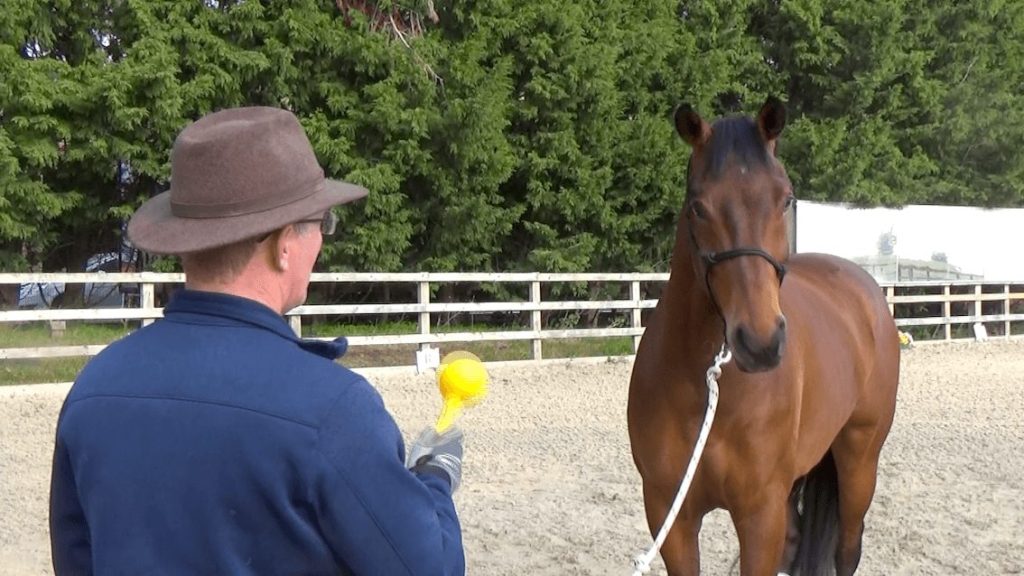
Spring: Lesson 3
Rattle
- Rattle
- Desensitise
- Unusual sounds
- Sensitive
- Explode
- Multiple choice questions
- Relaxation
- Pressure
- Desired behaviour
- Victor not a victim
What about noise? Your horse will learn that they are in control and stay calm.
Using a rattle in training is a bit unconventional, but it achieves two things. First, it desensitises your horse to unusual sounds, and it trains him that he can make the noise stop which is very empowering for a skittish horse. In this lesson, Jenku helps the very sensitive Senna learn that he can control what happens around him. When Jenku shakes the rattle, Senna’s first response is to back away or explode.
Watch as Senna runs through a series of multiple-choice questions while Jenku shakes the rattle. Should I look to the left, should I flick my ears, should I kick out with my hind legs, he asks? The rattle only stops when Senna shows signs of relaxation. Keeping the pressure on - until you get the desired behaviour - is a very useful training tool. The more you do these types of exercises, the more your horse will feel like a victor rather than a victim.
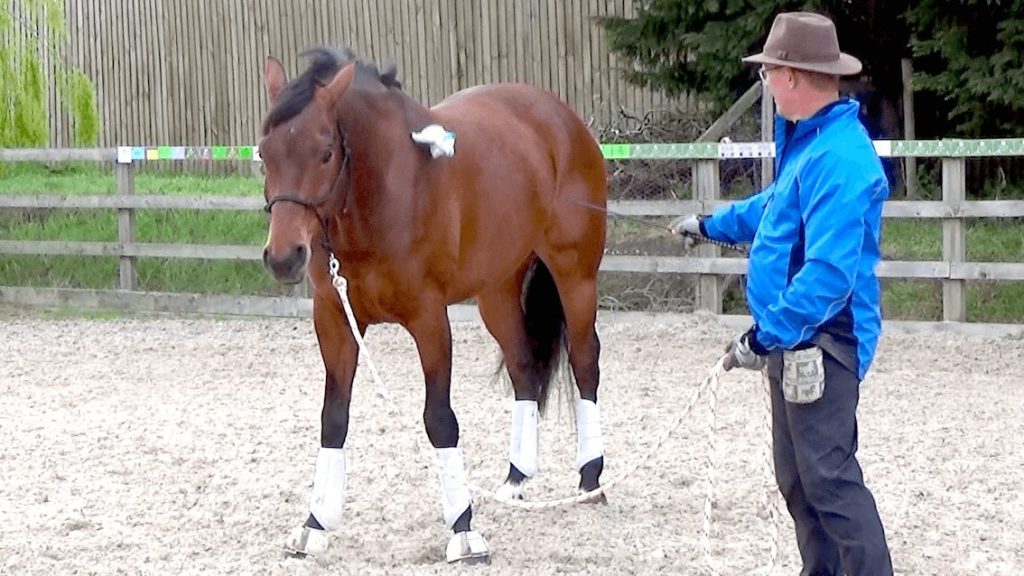
Spring: Lesson 4
Plastic Bag
- Set up for success
- Pressure and release
- Control
- Body language
- Hungry lion
- Lazy lion
- Mirror me
- Adrenaline
Your horse will even learn to cope with the 'dreaded plastic bag'!
For sensitive Senna, even the tiniest bit of plastic is terrifying. Tracy admits she has spent hours trying to get him close to a plastic bag but without success. In this lesson, Jenku sets Senna up for success by timing the 'pressure on and release' so that in the end Senna feels as though he’s in control of the scary bag. Surprisingly, at the end he learns to relax rather than explode.
Because horses are flight animals, they are acutely aware of other animals' body language, including us humans! Learn about the ‘hungry lion’ and the ‘ lazy lion’, switching your energy on and off and how horses can do the same in the game, 'Mirror Me'. Starting with the plastic bag on the end of a stick, Jenku puts the pressure on and then takes it off immediately Senna softens. Not only is this great for Senna as he doesn’t have to deal with adrenaline bursts, but it’s brilliant for Tracy as well. After all, nobody likes riding a horse that feels as though he’s walking on eggshells!
Downloadable Quick-Reference Cards
Lesson:Whip

First set boundaries. Raise your arm holding the rope and gently tap pastern with whip to back up - ‘tsk’ & reward.

Apply pressure stroking with whip handle behind the shoulder area - watch closely for signs of relaxation eg. licking and chewing, lowering the head - ‘tsk’ & reward.

If your horse moves away from you, keep the ‘pressure’ on until they stand still - then you can release the pressure - ‘tsk’ & reward.

Next apply light pressure on the lead rope to encourage head to lower - ‘tsk’ & reward even the smallest movement.

Repeat the whole process on the other side, starting from the beginning, keeping the strokes nice and firm.
REMEMBER:
Wear a hat, gloves and put a set of boots on your horse for safety. Spot the ‘smallest try’, immediately release pressure and reward.
Wear a hat, gloves and put a set of boots on your horse for safety. Spot the ‘smallest try’, immediately release pressure and reward.
- Spring
Summer Season
This season it is raining here in the UK so we start with our umbrella! You will see the process is the same - no matter what the weather throws at us your horse will learn to stay calm.

Summer: Lesson 1
Umbrella
- Neutral feet and mind
- Introducing multiple stimuli
- Learning how horses think in pictures
- Signs of flight mode
Horses 'think in pictures' - an umbrella can be a tricky for them to figure out.
Summer in England often means unexpected rain and, while Tracy might not want to ride with an umbrella, she’s bound to come across them at shows. For super-sensitive Senna, umbrellas can be frightening. In this lesson, Jenku introduces Senna to an umbrella in a rolled-up form. Because of the work done in the Spring season, he quickly finds ‘neutral feet and mind’.
Jenku then up’s the criteria and starts opening it. Now the horse must deal with multiple stimuli. Horses think in pictures and shapes and when Jenku picks up the umbrella, Senna hits flight mode – blood rushes to his muscles, his back contracts, his head is raised, and his pupils dilate. If he needs to run for his life, he is more than ready! All the training that Tracy has done with him is paying off, however, and as soon as he starts softening the pressure is removed. Teaching your horse to find calm is essential for his well-being and your safety. Before you know it, Senna will be doing a musical kur to Singing in the Rain – with umbrellas!
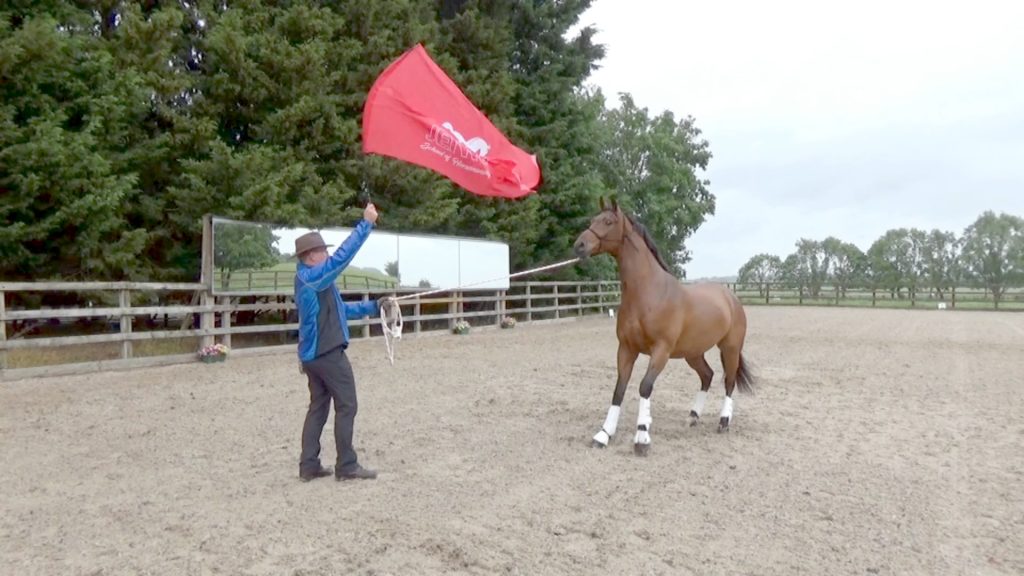
Summer: Lesson 2
Flag Part 2
- Training proactively rather than reactively
- Introducing multiple stimuli
- Training your horse to make a conscious choice
- Signs of relaxation
- Horse psychology and long-term memory
Now the situation get more challenging as the flag is waved overhead.
Scatterproofing a young horse is very important; and it’s much better to train proactively rather than reactively. In this lesson, Senna faces the flag again and this time it’s a lot less scary! Jenku explains how this exercise deals with four senses;
- visual - where your horse is encouraged to look at the exciting and interesting object you’re holding.
- tactile - your horse is asked to touch the object.
- audio - where your horse can hear the flag flapping in the wind.
Finally Jenku ups the criteria and waves the flag overhead and you can see Senna making a choice to override his desire to freak out! He has done brilliantly to remember to lower his head and stay calm since the last session in the Spring season. This reinforces the fact that any learning that happens when the horse is relaxed will be retained and goes into their long-term memory.

Summer: Lesson 3
Plastic Bag Part 2
- Safety precautions
- Recognizing and rewarding the smallest try
- Pattern recognition
- Pressure and release
- Training the process of making the right decision
It's all about helping your horse make the right decision in scary situations.
In this lesson, Senna revisits the ‘dreaded plastic bag’... yikes! The bag is terrifying for him and his first instinct is to attack it – much as he would a threatening animal in the wild. In the past, Tracy and Senna have struggled with the bag for hours without success. He’s bound to remember how stressful that was - Tracy certainly does! Jenku emphasises that recognising the smallest try - whether it’s an ear cocked in the bag’s direction or looking at the bag - and taking the pressure off, will help the horse to be more confident about his choice to lower his head.
As Jenku explains; 'your focus is important. Are you focusing on what the horse is doing right or what he is doing wrong? It’s all about pattern recognition for the horse'. Senna quickly learns that every time you touch him, if he lowers his nose to the ground, you’ll take the pressure off by taking the bag away AND you’ll reward him. As Tracy points out, this method teaches him the process of making the right decision about the bag, rather than forcing him to touch the bag.
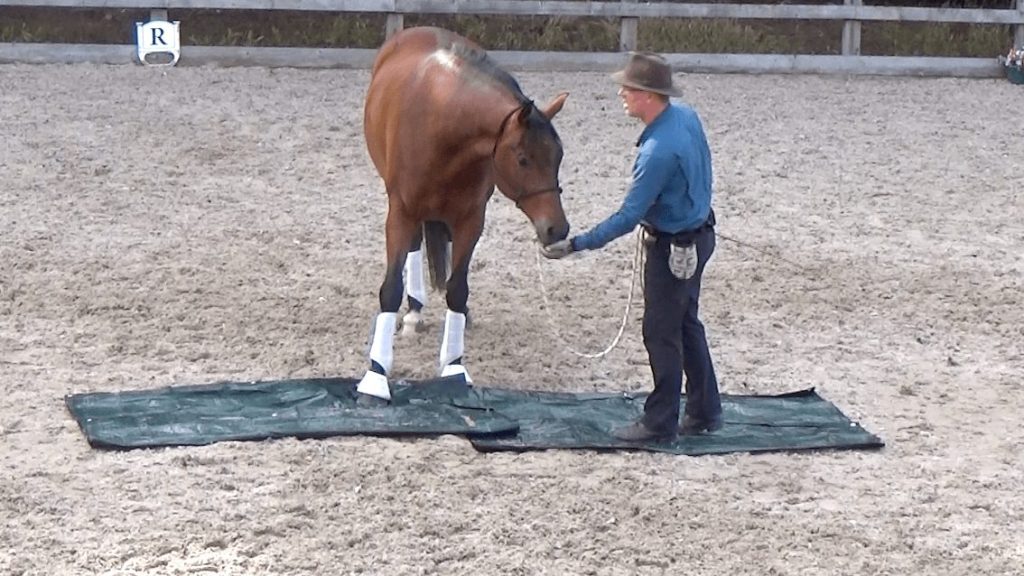
Summer: Lesson 4
Tarpaulin
- Application for various spooky obstacles and situations eg. water jumps
- Judge’s box
- Incremental training
- Calming the horse’s nervous system
- Building confidence
One of our favourites - check out Senna's face as he 'owns it' at the end.
Who would have thought that Senna would be able to 'find neutral' and relax whilst standing on a scrunchy, noisy tarpaulin? Walking over tarpaulins, or through ditches and streams can be unnerving for a spooky horse. But, breaking it down into incremental bite-size chunks will calm your horse’s nervous system and make learning rewarding instead of terrifying.
Getting your horse to walk over a tarpaulin can be broken down into six steps. These steps set your horse up for success as you let your horse figure out what to do. Senna starts out not wanting to go anywhere near the tarp but ends up standing on it without a care in the world. This is an excellent lesson for show jumpers who want their horses to clear the water jumps, or dressage riders struggling to get their horse passed a judge’s box. Giving your horse time to figure out half an answer for himself, is much better than you providing him with the whole answer.
Downloadable Quick-Reference Cards
Lesson:Umbrella

Introduce the umbrella to your horse in a rolled-up form. Use it to rub your horse as per ‘whip’ lesson (Spring season) to find ‘neutral feet and mind’.

As soon as your horse starts softening - ‘tsk’ and take the umbrella away to take the ‘pressure off ’ and reward. Repeat on both sides.

Gradually unfold the umbrella and repeat. If you horse gets tense keep the ‘pressure on’ until they relax. Pay close attention to any small sign of softening.

Next open and close the umbrella (like a jelly fish). Keep opening and closing until you see signs of relaxation and then stop - tsk and reward.

Repeat the process raising (pressure on) and lowering (pressure off ) the umbrella up. Finally the aim is to hold the umbrella over your horses back.
REMEMBER:
Each time you change sides, the umbrella will appear ‘new’ to your horse, so you must start the process from the beginning.
Each time you change sides, the umbrella will appear ‘new’ to your horse, so you must start the process from the beginning.
- Summer
Autumn Season
Our lessons become more challenging this season, as the props are now waving overhead. Learn how to use a 'rubber mat' as a visual anchor to help your horse relax in any situation.
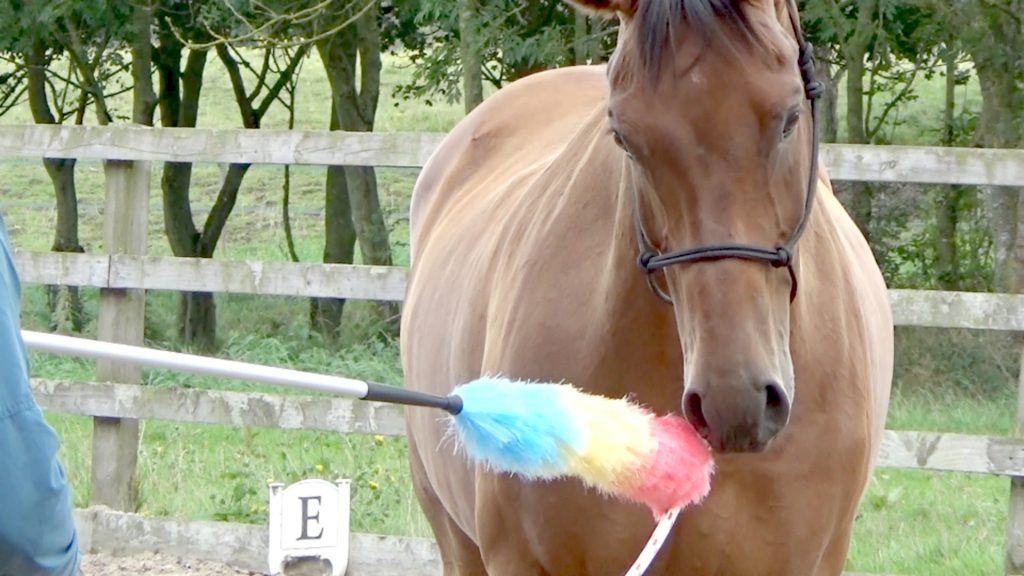
Autumn: Lesson 1
Progressive Props
- Plastic bag
- Feather duster
- Preservation instinct
- Flight mode
- Neutral feet and mind
- Advance and retreat
- Pressure and release
- Three agreements
- Parasympathetic state
Senna is in flight mode, but Jenku is calm and consistent - a true master.
Senna’s eyes are about to pop out of their sockets! A plastic bag is scary enough, but now there’s a fluffy feather duster to contend with. Like Senna, you might be wondering what a feather duster has to do with good horse training. Because his preservation instinct is so strong and he’s ready to flee at the sight of anything vaguely scary, it’s important to remind him that neutral mind and feet are what we’re after.
Senna needs to realise that when he stands still, the scary object goes away, but that if he keeps rushing backwards or kicking out, the object remains at his side. In this lesson, Jenku makes 'advance and retreat' look simple, but his timing needs to be spot on. As soon as Senna softens – no matter how subtly – he removes the pressure. By rewarding the 'smallest try', this boosts Senna’s confidence in his ability to control his environment. A horse can only learn if he’s in the parasympathetic, or rest and digest, state. For this reason, you need to train calmness into your horse otherwise you’ll never be able to achieve the goals you’ve carved out for yourself.

Autumn: Lesson 2
Rubber Mat
- Rubber car mat
- Powerful training tool
- Neutral place
- Relaxation
- Hind quarter yield
- Mounting block
- Calmness
The rubber mat is Senna's 'happy place' - it travels everywhere with him!
Who knew that a rubber car mat could be such a powerful training tool? For sensitive Senna, a neutral place where he can relax is very important. In this lesson, Jenku trains him to 'find neutral' on the car mat by setting up boundaries. At first when he sees the mat, he backs away but Jenku blocks him and rewards him when he takes a step towards it. Senna soon learns that he can’t go sideways, or backwards but that through a process of elimination if he steps on the mat, he will be clicked and rewarded.
Next Jenku uses the mat to teach Senna to 'find neutral' at the mounting block. In Senna’s mind, he knows that the mat is neutral and stands on it to be rewarded. If he’s suspicious of the mounting block to begin with, these worries soon fall away as he is rewarded for standing quietly on the mat. Once up on the block, Jenku is able to control Senna’s body by using a hind quarter yield until he’s standing quietly parallel to the mounting block. You can use the mat in so many situations to help calm your horse’s nerves - at competitions, on the horse box ramp, or near 'horse-eating' arena mirrors!
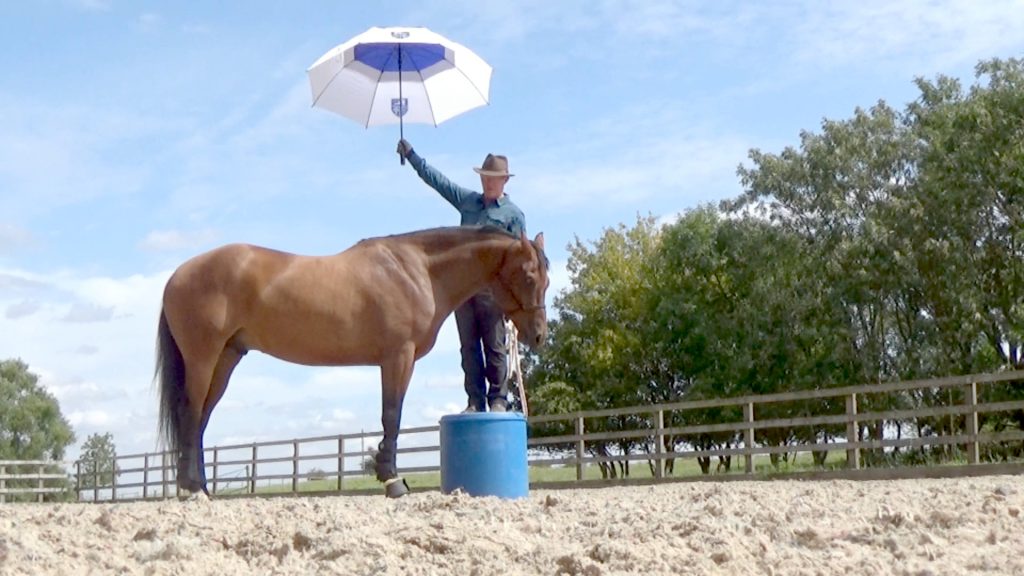
Autumn: Lesson 3
Overhead Props
- Recap on previous props
- Umbrella
- Flag
- Feather duster
- Bombproofing
- Competition simulation
- Operant conditioning
- Neutral feet and mind
Oops! Jenku pressed the open button by accident - a true test of our training!
In this lesson, Mary Poppins meets up with 600kgs of horse power and a small mistake ends up being a big test for Senna. Bringing out lots of props to play with isn’t just about having fun with your horse. It’s about training him to be bombproof and keep you safe, no matter what the situation. As Jenku says, ‘you want to be on the ground wishing you were on your horse, rather than on your horse wishing you were on the ground’. For a competition horse like Senna, flags, hazard tape, umbrellas and sound systems are going to be a part of his world, so the sooner he learns to deal with them, the better.
Because Senna is very suspicious by nature, it’s always better to start off with a prop he is familiar with, recap what he’s learnt, and reinforce the default behaviour which is to lower his head and find neutral mind and feet. All cool? Great, now you’re ready to hop up onto the mounting block and try waving it overhead. When Jenku pushes the umbrella button by mistake, Senna handles it really well. He didn’t overreact – which is exactly what you want. Well done, Senna. You handled this like a pro.
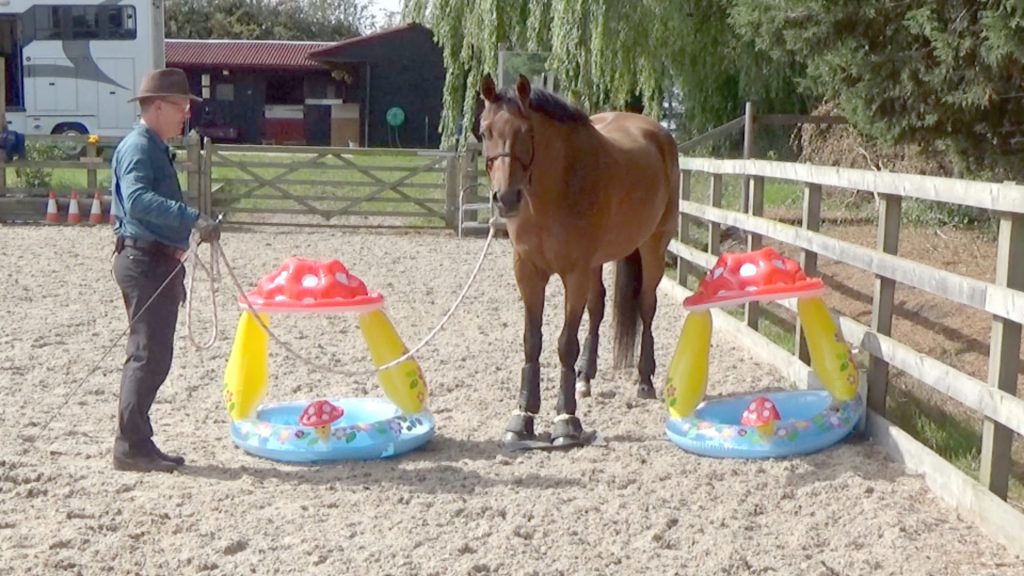
Autumn: Lesson 4
Between Props
- Placing mat between props
- Tents
- Tubes
- Brightly-coloured inflatables
- Lateral thinkers
- Prey animals
- Allow time to explore
- Developing mentally
- Calmness
- Consistent fair leader
- Trust
- Feeling in control of environment
I spy a rubber mat - so all good between the scary props then Senna?
In this lesson Jenku gets friendly with a flamingo and Senna learns to find neutral between some very challenging props! Because horses eyes are on the side of their heads, they are lateral thinkers. Jenku teaches us why this is so important to understand when training your horse. Senna understands from a previous lesson that a rubber car mat is his ‘happy’ place.
By placing the mat on the ground between tents, tubes, and other brightly-coloured objects that would usually push all his panic buttons, instead he quickly learns to find ‘neutral’. The one constant in your horse’s life is you, so if you are fair and consistent, he’ll be more inclined to trust you and follow your lead. The aim of this, and all the other exercises, is to help your horse feel confident and in control of his environment rather than a victim. Tracy is happy to observe that even though the props get scarier as the lesson progresses (there’s even a crocodile!), Senna is quicker to find neutral each time. In fact, he’s so happy on the mat that Jenku has to encourage him to leave it!
Downloadable Quick-Reference Cards
Lesson:Progressive Props

Start by re-establishing ‘the three agreements’ as learned in summer season. Your aim, is for your horse to realize if they stand still, the bag will go away.

Bring the bag towards your horse to add ‘visual pressure’ (advance) and reward your horse for staying still by taking the bag away (retreat).

Next add ‘tactile pressure’ by touching your horse on the shoulder with the bag (advance) and reward your horse for standing still. Repeat on both sides.

If you get stuck, use your horses biomechanics as a technique to stay in control. Use the ‘hind quarter yield’ to keep one hind leg moving at a time.

Finally swap the bag for a feather duster and repeat the process. Focus on your timing, and reward the 'smallest try' to boost your horse’s confidence.
REMEMBER:
This training is key, as your horse can only learn when they are relaxed and calm, in ‘parasympathetic’ (rest and digest) state.
This training is key, as your horse can only learn when they are relaxed and calm, in ‘parasympathetic’ (rest and digest) state.
- Autumn
Winter Season
In this season, we put our training to the test and head to an international competition venue. By learning these techniques your horse will perform at their best in any environment.

Winter: Lesson 1
Neutral Under Saddle
- Tension
- Parasympathetic state
- Back muscles contracted
- Relaxation
- Jaw release
- Targeting belt buckle
- One rein for control
- Two reins for collection
- Dopamine
Learn the golden rule - one rein for control, two reins for collection.
Getting on a tense young horse requires nerves of steel. Senna is always firing on all cylinders so the goal is to get him soft and relaxed so that he can work through his whole body. Asking him to release his jaw is the first step to relaxation and eventually this will transfer to his neck and down his back. Jenku lifts the bit gently so that there is pressure on the mouth corners. The moment he releases his jaw he clicks and rewards.
Once he is doing this consistently, Jenku transfers the pressure to Tracy. She lifts her hands to create upward pressure on Senna’s mouth and he stretches down. Tracy is well-aware that too much pressure makes Senna claustrophobic and that’s when he panics. Trying to control this volatile energy is not easy! When he is in a tizzy, she uses one rein for control to get his hind quarters to yield so that he can move sideways until he finds the release he’s looking for. By the end of the session, wild-eyed Senna has dopey eyes and his body is heavy and relaxed. Dopamine has flooded his system and he’s learned how to relax. His engine is purring, instead of roaring!
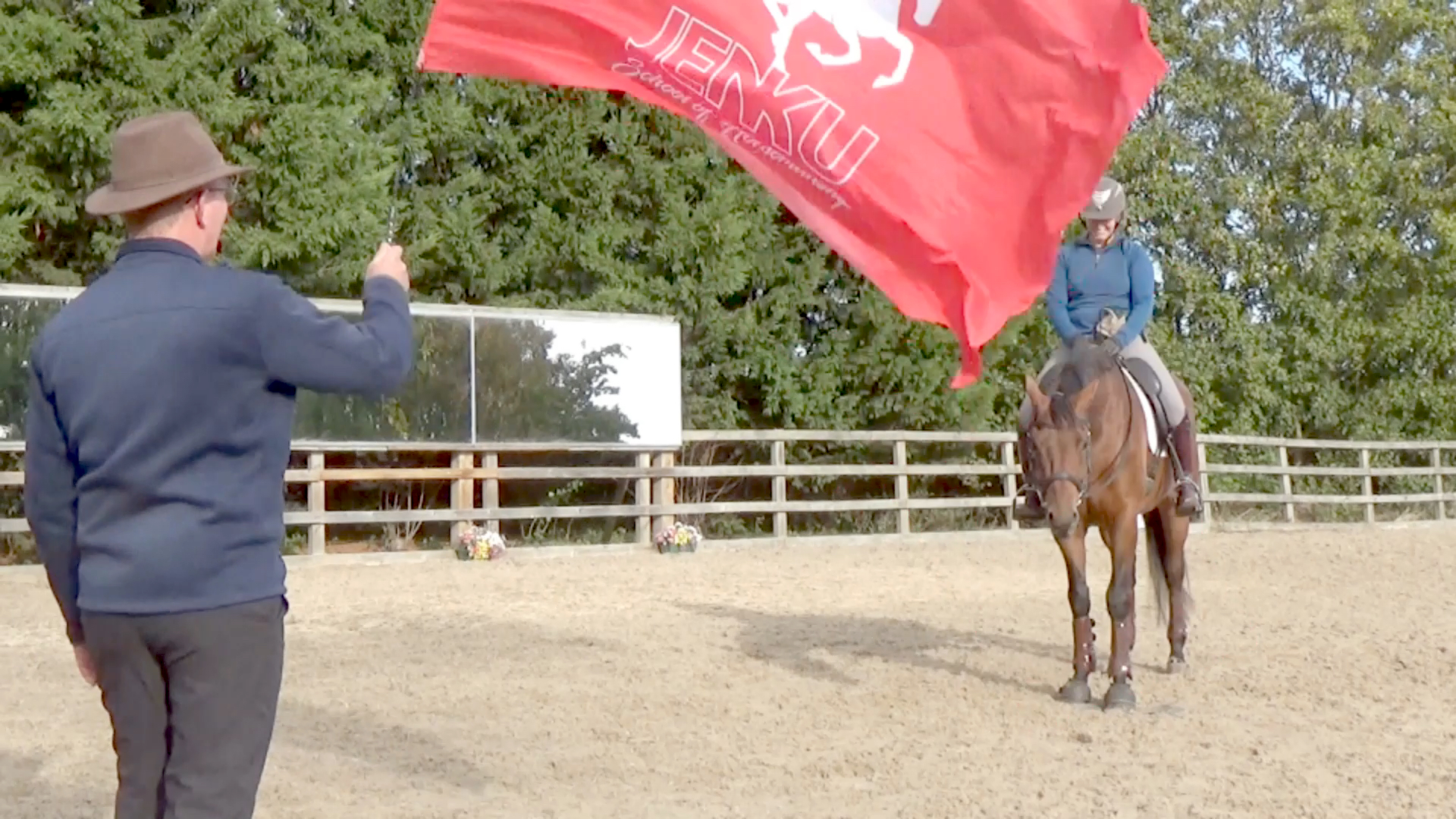
Winter: Lesson 2
Neutral with Flag
- Nervous system
- Finding neutral
- Invisible box
- Rubber mat
- Overlaying
- Relaxation
- Mounting block
- Choice rather than force
- Flag
A rider AND a flag - there was time when this would have been impossible!
Cooling your horse’s nervous system will make riding better for you - and him. In this lesson Senna discovers that 'finding neutral' next to Tracy is the best place to be. Remember the rubber mat from previously? So does Senna! He quickly ‘finds neutral’ on the mat so we start overlaying other cues. Can Senna stand on the mat and stretch down when you take up the rein? The more he answers 'Yes, I can', the more he relaxes.
While lots of repetition might not be exciting for the rider, it’s really important for Senna to feel that he is making a choice for himself rather than being forced or manipulated into position. Horses are often coerced or manipulated into positions but if you were to ask them what they’ve learned he would say, “I don’t know but they pushed and pulled me a lot and I’m glad the lesson is over.” Instead, giving him the choice, he’s left with the feeling that being next to Tracy is the best place to be. Now the BIG test is to see if Senna can maintain neutral feet and mind when Jenku waves a flag around him. Awesome! Senna doesn’t flinch. Tracy is thrilled that the fiery Incendio is cooling down.
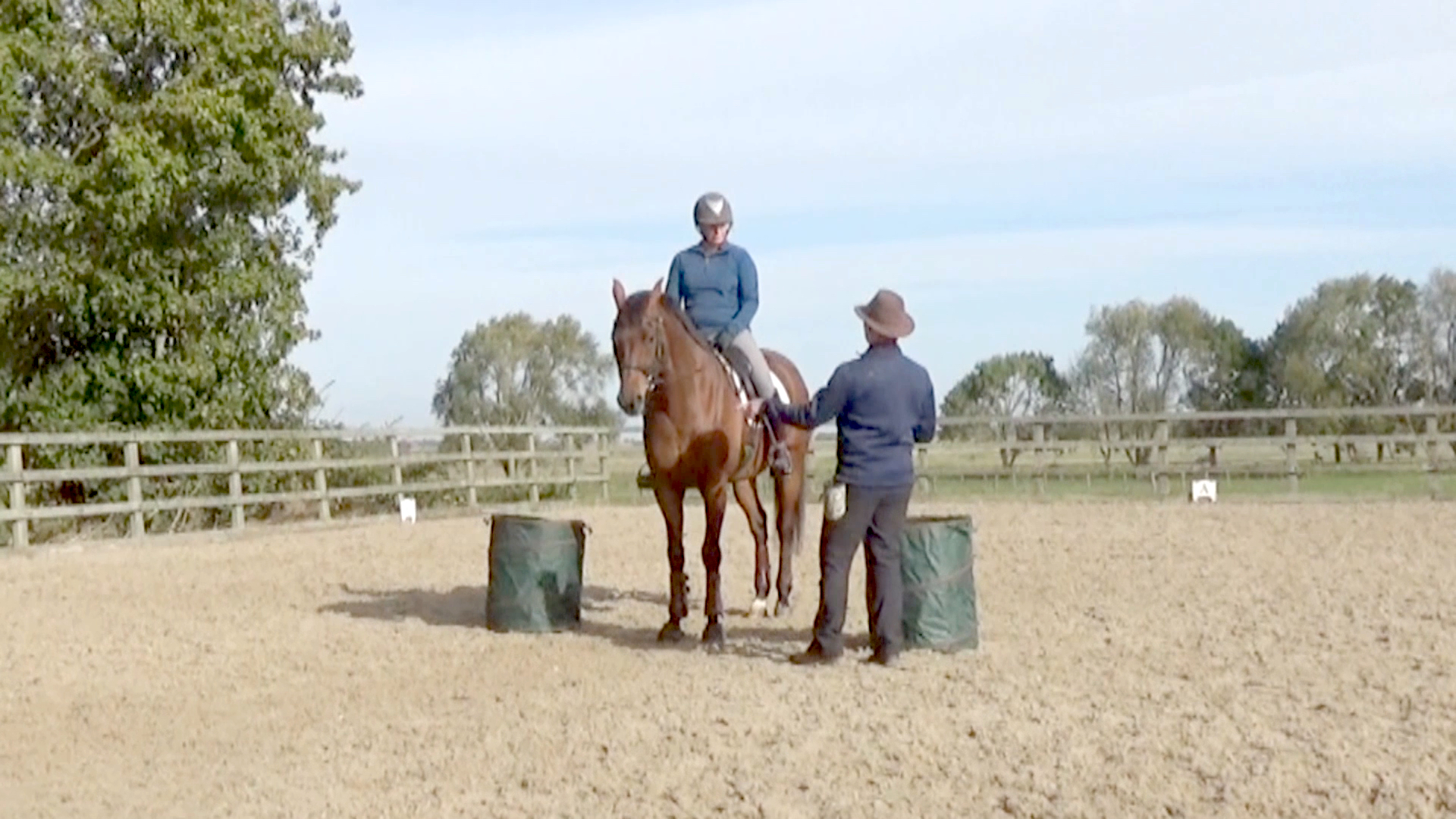
Winter: Lesson 3
Neutral Between Props
- Zen master
- Rubber mat
- Scary props
- Confidence
- Visual anchor
- Flexibility
- Relaxation
- Gaining control using one rein
- Disengaging hind quarters
This is a break through moment - finally Senna is truly relaxed under saddle.
Senna is now a Zen master! He’s found his sweet spot on the rubber mat and in this lesson we take it to the next level. Jenku starts by putting out two props at least 5 metres apart so that there is ample space to go forward between the props. If Jenku makes the gap too small and Senna slams on brakes and run backwards, then he hasn’t been set up to succeed. The mat in between the props is a visual anchor.
Tracy starts by walking up to the mat where Senna is happy to stand and stretch down. Feeding him from the saddle increases his flexibility which, in turn, increases his relaxation. The next step is to gradually decrease the gap. With the mat as a mental anchor, the props are almost unnoticed! In the past, an arena full of props would have been overwhelming for him and although Senna has a wobbly moment meeting the crocodile (who can blame him?), Tracy is able to gain control using one rein and he quickly finds neutral again. For Tracy, this is a huge breakthrough. After some hairy moments on Senna’s back, he finally seems to be trusting her. Most riders on skittish horse know what a huge step this is. Take a bow, Tracy and Senna.
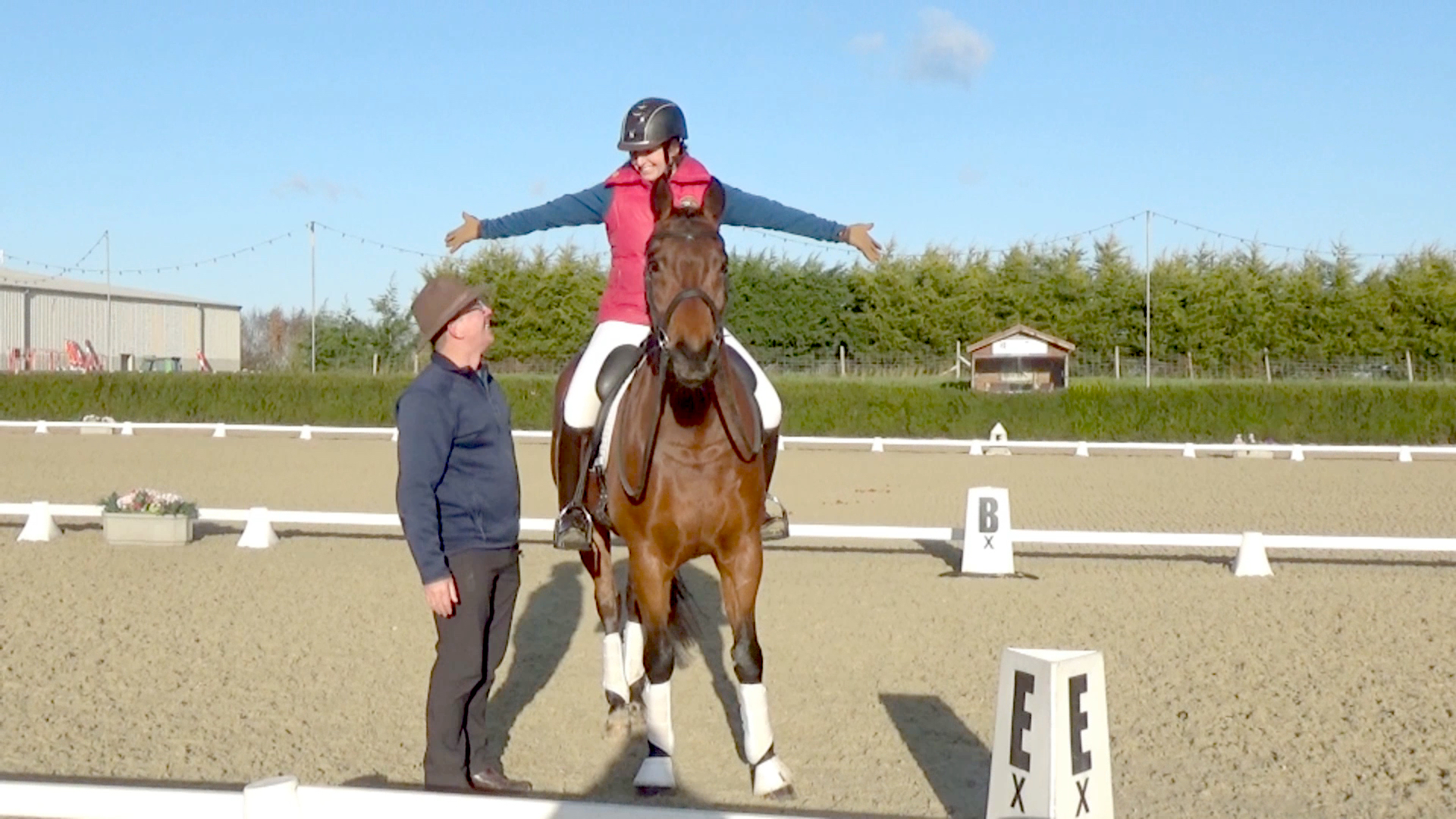
Winter: Lesson 4
Competition Time
- Real-life application
- Competition venue
- Overlaying
- Targeting a cone
- Arena letters
- Finding neutral
- Relaxation
- Biomechanics
- Loosen lower back
- Rewarding the smallest try
Senna now has an amazing foundation to build a successful career.
Everything in this program is about preparing for real-life applications. In this lesson we set up a simulation at home, which we can overlay at a show or in any stressful situation. If your horse knows the 'buttons', all you need to do is push them. Tracy and Senna put this to the test at the Regional Dressage Championships where the horses and riders are tense, and the stakes are high. Senna knows how to 'find neutral' when targeting a cone at home, so at the show Tracy uses this training and targets the arena letters to 'find neutral'. This helps Senna relax and Tracy is able to block out background distractions.
In these tense situations, it’s important to remember your biomechanics. Your horse’s poll can’t be up and flexed to the side at the same time, so if he’s treading on eggshells, ask for a lateral bend and release as soon as he drops his poll. Shoulder in on four tracks is another good tool as it will loosen his lower back behind the saddle. Even though Senna finds the competition venue very frightening, by overlaying the simulation learned at home he soon soon finds neutral feet and neutral mind. Good job, Senna!
Downloadable Quick-Reference Cards
Lesson:Neutral Under Saddle

Relaxation starts in the jaw. From the ground, lift the bit gently with your thumbs up into the mouth corners - ‘tsk’ and reward when the jaw releases.

Once consistent, repeat from the saddle. Lift both hands to create upward pressure on the mouth -‘ tsk’ and reward as your horse stretches down.

The lesson of the hand. Use one rein to bend your horse’s neck. At fi rst your horse may start circling - ‘tsk’ and release pressure when they stand still.

The lesson of the leg. On a 20m circle in walk, turn to position your horse in a steep ‘shoulder in’ angle so that the hind leg is crossing each step.

Gradually your horse will submit to the aids, learn to use the global muscle in the hind quarters, and finally find, and enjoy the feeling of relaxation.
REMEMBER:
The golden rule; use one rein for ‘control’ - by disengaging the hind quarters, and two reins for ‘collection’ - by making the ‘invisible box’ smaller.
The golden rule; use one rein for ‘control’ - by disengaging the hind quarters, and two reins for ‘collection’ - by making the ‘invisible box’ smaller.
- Winter
